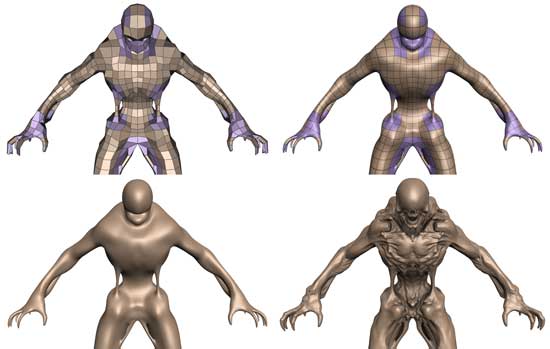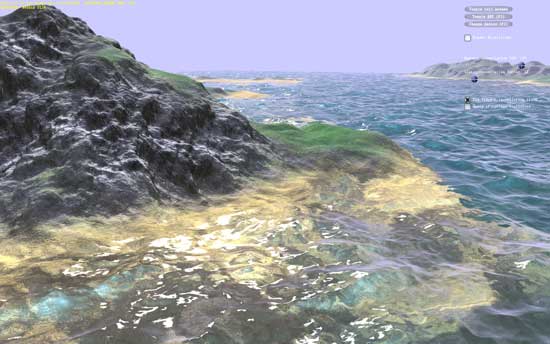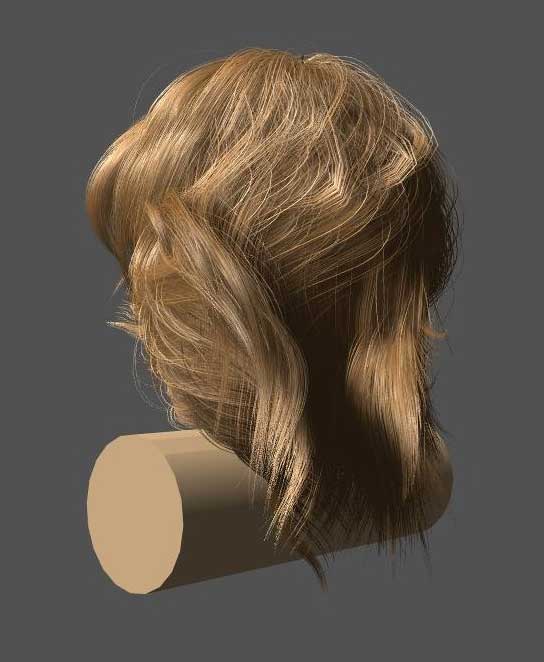Why NVIDIA Is Focused On Geometry
Up until now we haven’t talked a great deal about the performance of GF100, and to some extent we still can’t. We don’t know the final clock speeds of the shipping cards, so we don’t know exactly what the card will be like. But what we can talk about is why NVIDIA made the decisions they did: why they went for the parallel PolyMorph and Raster Engines.
The DX11 specification doesn’t leave NVIDIA with a ton of room to add new features. Without the capsbits, NVIDIA can’t put new features on their hardware and easily expose them, nor would they want to at risk of having those features (and hence die space) go unused. DX11 rigidly says what features a compliant video card should offer, and leaves you very little room to deviate.
So NVIDIA has taken a bit of a gamble. There’s no single wonder-feature in the hardware that immediately makes it stand out from AMD’s hardware – NVIDIA has post-rendering features such as 3D Vision or compute features such as PhysX, but when it comes to rendering they can only do what AMD does.
But the DX11 specification doesn’t say how quickly you have to do it.

Tessellation in action
To differentiate themselves from AMD, NVIDIA is taking the tessellator and driving it for all its worth. While AMD merely has a tessellator, NVIDIA is counting on the tessellator in their PolyMorph Engine to give them a noticeable graphical advantage over AMD.
To put things in perspective, between NV30 (GeForce FX 5800) and GT200 (GeForce GTX 280), the geometry performance of NVIDIA’s hardware only increases roughly 3x in performance. Meanwhile the shader performance of their cards increased by over 150x. Compared just to GT200, GF100 has 8x the geometry performance of GT200, and NVIDIA tells us this is something they have measured in their labs.
So why does NVIDIA want so much geometry performance? Because with tessellation, it allows them to take the same assets from the same games as AMD and generate something that will look better. With more geometry power, NVIDIA can use tessellation and displacement mapping to generate more complex characters, objects, and scenery than AMD can at the same level of performance. And this is why NVIDIA has 16 PolyMorph Engines and 4 Raster Engines, because they need a lot of hardware to generate and process that much geometry.
NVIDIA believes their strategy will work, and if geometry performance is as good as they say it is, then we can see why they feel this way. Game art is usually created at far higher levels of detail than what eventually ends up being shipped, and with tessellation there’s no reason why a tessellated and displacement mapped representation of that high quality art can’t come with the game. Developers can use tessellation to scale down to whatever the hardware can do, and in NVIDIA’s world they won’t have to scale it down very far to meet up with the GF100.
At this point tessellation is a message that’s much more for developers than it is consumers. As DX11 is required to take advantage of tessellation, only a few games exist while plenty more are on the way. NVIDIA needs to convince developers to ship their art with detailed enough displacement maps to match GF100’s capabilities, and while that isn’t too hard, it’s also not a walk in the park. To that extent they’re also extolling the other virtues of tessellation, such as the ability to do higher quality animations by only needing to animate the control points of a model, and letting tessellation take care of the rest. A lot of the success of the GF100 architecture is going to ride on how developers respond to this, so it’s going to be something worth keeping an eye on.

NVIDIA's water tessellation demo

NVIDIA's hair tessellation demo










115 Comments
View All Comments
SothemX - Tuesday, March 9, 2010 - link
WELL.lets just make it simple. I am an advid gamer...I WANT and NEED power and performance. I care only about how well my games play, how good they look, and the impression they leave with me when I am done.I own a PS3 and am thrilled they went with Nvidia- (smart move)
I own and PC that utilizes the 9800GT OC card....getting ready to upgrade to the new GF100 when it releases, last thing that is on my mind is how the market share is, cost is not an issue.
Hard-Core gaming requires Nvidia. Entry-level baby boomers use ATI.
Nvidia is just playing with their food....its a vulgar display of power- better architecture, better programming, better gamming.
StevoLincolnite - Monday, January 18, 2010 - link
[quote]So why does NVIDIA want so much geometry performance? Because with tessellation, it allows them to take the same assets from the same games as AMD and generate something that will look better. With more geometry power, NVIDIA can use tessellation and displacement mapping to generate more complex characters, objects, and scenery than AMD can at the same level of performance.[/quote]Might I add to that, nVidia's design is essentially "Modular" they can increase and decrease there geometry performance essentially by taking units out, this however will force programmers to program for the lowest common denominator, whilst AMD's iteration of the technology is the same across the board, so essentially you can have identical geometry regardless of the chip.
Yojimbo - Monday, January 18, 2010 - link
just say the minimum, not the lowest common denominator. it may look fancy bit it doesn't seem to fit.chizow - Monday, January 18, 2010 - link
The real distinction here is that Nvidia's revamp of fixed-function geometry units to a programmable, scalable, and parallel Polymorph engine means their implementation won't be limited to acceleration of Tesselation in games. Their improvements will benefit every game ever made that benefits from increased geometry performance. I know people around here hate to claim "winners" and "losers" around here when AMD isn't winning, but I think its pretty obvious Nvidia's design and implementation is the better one.Fully programmable vs. fixed-function, as long as the fully programmable option is at least as fast is always going to be the better solution. Just look at the evolution of the GPU from mostly fixed-function hardware to what it is today with GF100...a fully programmable, highly parallel, compute powerhouse.
mcnabney - Monday, January 18, 2010 - link
If Fermi was a winner Nvidia would have had samples out to be benchmarked by Anand and others a long time ago.Fermi is designed for GPGPU with gaming secondary. Goody for them. They can probably do a lot of great things and make good money in that sector. But I don't know about gaming. Based upon the info that has gotten out and the fact that reality hasn't appeared yet I am guessing that Fermi will only be slightly faster than 5870 and Nvidia doesn't want to show their hand and let AMD respond. Remember, AMD is finishing up the next generation right now - so Fermi will likely compete against Northern Isles on AMDs 32nm process in the Fall.
dragonsqrrl - Monday, February 15, 2010 - link
Firstly, did you not read this article? The gf100 delay was due in large part to the new architecture they developed, and architectural shift ATI will eventually have to make if they wish to remain competitive. In other words, similarly to the g80 enabling GPU computing features/unified shaders for the first time on the PC, Nvidia invested huge resources in r&d and as a result had a next generation, revolutionary GPU before ATI.Secondly, Nvidia never meant to place gaming second to GPU computing, as much as you ATI fanboys would like to troll about this subject. What they're trying to do is bring GPU computing up to the level GPU gaming is already at (in terms of accessibility, reliability, and performance). The research they're doing in this field could revolutionize research into many fields outside of gaming, including medicine, astronomy, and 'yes' film production (something I happen to deal with a LOT) while revolutionizing gaming performance and feature sets as well
Thirdly, I would be AMAZED if AMD can come out with their new architecture (their first since the hd2900) by the 3rd quarter of this year, and on the 32nm process. I just can't see them pushing GPU technology forward in the same way Nvidia has given their new business model (smaller GPUs, less focus on GPU computing), while meeting that tight deadline.
chewietobbacca - Monday, January 18, 2010 - link
"Winning" the generation? What really matters?The bottom line, that's what. I'm sure Nvidia liked winning the generation - I'm sure they would have loved it even more if they didn't lose market share and potential profits from the fight...
realneil - Monday, January 25, 2010 - link
winning the generation is a non-prize if the mainstream buyer can only wish they had one. Make this kind of performance affordable and then you'll impress me.chizow - Monday, January 18, 2010 - link
Yes and the bottom line showed Nvidia turning a profit despite not having the fastest part on the market.Again, my point about G80'ing the market was more a reference to them revolutionizing GPU design again rather than simply doubling transistors and functional units or increasing clockspeeds based on past designs.
The other poster brought up performance at any given point in time, I was simply pointing out a fact being first or second to market doesn't really matter as long as you win the generation, which Nvidia has done for the last few generations since G80 and will again once GF100 launches.
sc3252 - Monday, January 18, 2010 - link
Yikes, if it is more than the original GTX 280 I would expect some loud cards. When I saw those benchmarks of farcrry 2 I was disappointed that I didn't wait, but now that it is using more than a GTX 280 I think I may have made the right choice. While right now I wan't as much performance as possible eventually my 5850 will go into a secondary pc(why I picked 5850) with a lesser power supply. I don't want to have to buy a bigger power supply just because a friend might come over and play once a week.